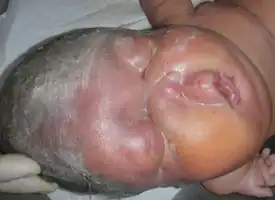Hydrops-ectopic calcification-moth-eaten skeletal dysplasia
| Hydrops-ectopic calcification-moth-eaten skeletal dysplasia | |
|---|---|
| Other names: Greenberg dysplasia,[1] HEM dysplasia, Autosomal recessive lethal chondrodystrophy with congenital hydrops[2] | |
 | |
| Photograph of a child with Hydrops-ectopic calcification-moth-eaten skeletal dysplasia. | |
| Specialty | Medical genetics |
| Differential diagnosis | severe hydrops fetalis, phokomelia on antenatal songraphy[3] |
Hydrops-ectopic calcification-moth-eaten skeletal dysplasia is a defect in cholesterol biosynthesis.[4] Greenberg characterized the condition in 1988.[5]
It has been associated with the lamin B receptor.[6]
Signs and Symptoms
Hydrops-ectopic calcification-moth-eaten skeletal dysplasia causes the bones in a fetus to develop abnormally. This leads to a characteristic "moth eaten" appearance of the bones when viewed under an X-ray. Micromelia, polydactyly and ectopic calcification, or the built up of calcium in the soft tissues of the body, may all occour. Eighty to ninety nine percent of effected individuals will have abnormally ossified vertebrae, abnormal pelvis bone ossification, anterior rib punctate calcifications and brachydactyly. [7]
The second defining feature of Hydrops-ectopic calcification-moth-eaten skeletal dysplasia is hydrops fetalis.[8]A condition wherein an abnormal buildup of fluids occurs in the tissues of a fetus.[9]
 Hypoplastic face
Hypoplastic face An infant with Hydrops-ectopic calcification-moth-eaten skeletal dysplasia showing shortened limbs.
An infant with Hydrops-ectopic calcification-moth-eaten skeletal dysplasia showing shortened limbs.
Cause
The cause of this condition is a mutation in copies of the lamin B receptor gene located on chromosome 1[10]
Diagnosis
In terms of the diagnosis of Hydrops-ectopic calcification-moth-eaten skeletal dysplasia, prenatal ultrasound can detect the bone abnormalities, as well as hydrops fetalis; clinical examination, X-rays, may be done as well.[10]
See also
- Ectopic calcification
- Hydrops
References
- ↑ Trajkovski Z, Vrcakovski M, Saveski J, Gucev ZS (September 2002). "Greenberg dysplasia (hydrops-ectopic calcification-moth-eaten skeletal dysplasia): prenatal ultrasound diagnosis and review of literature". Am. J. Med. Genet. 111 (4): 415–9. doi:10.1002/ajmg.10578. PMID 12210303.
- ↑ "Greenberg dysplasia". National Organisation for Rare Disorders. Archived from the original on June 24, 2021. Retrieved June 23, 2021.
- ↑ "Greenberg dysplasia". Rarediseases.org. Archived from the original on June 24, 2021. Retrieved June 23, 2021.
- ↑ Herman GE (April 2003). "Disorders of cholesterol biosynthesis: prototypic metabolic malformation syndromes". Hum. Mol. Genet. 12. Spec No 1 (90001): R75–88. doi:10.1093/hmg/ddg072. PMID 12668600.
- ↑ Greenberg CR, Rimoin DL, Gruber HE, DeSa DJ, Reed M, Lachman RS (March 1988). "A new autosomal recessive lethal chondrodystrophy with congenital hydrops". Am. J. Med. Genet. 29 (3): 623–32. doi:10.1002/ajmg.1320290321. PMID 3377005.
- ↑ Konstantinidou A, Karadimas C, Waterham HR, et al. (April 2008). "Pathologic, radiographic and molecular findings in three fetuses diagnosed with HEM/Greenberg skeletal dysplasia". Prenat. Diagn. 28 (4): 309–12. doi:10.1002/pd.1976. PMID 18382993.
- ↑ "Greenberg dysplasia". National Organisation for Rare Disorders. Archived from the original on June 24, 2021. Retrieved June 23, 2021.
- ↑ "Greenberg dysplasia". Orphanet. Archived from the original on June 24, 2021. Retrieved June 23, 2021.
- ↑ "Hydrops Fetalis: Causes, Outlook, Treatment and More". Healthline. Archived from the original on June 24, 2021. Retrieved June 23, 2021.
- 1 2 "Greenberg dysplasia | Genetic and Rare Diseases Information Center (GARD) – an NCATS Program". rarediseases.info.nih.gov. Archived from the original on 28 August 2021. Retrieved 5 August 2021.
External links
| Classification | |
|---|---|
| External resources |
|